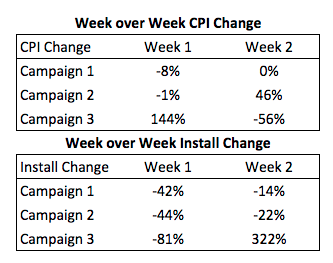March 27, 2018
We’ve all been there: after launching your discovery campaign, it’s time to check out your data to see how audiences reacted to your campaign strategy. Typically, you’d run a demographics report and see how different ages and genders performed against your KPI’s, and then target the high performing audiences at a greater bid or increased budget or not at all. Different platforms have different ways of targeting demographic audiences, and Apple ads is no exception.
The Test
After initially running Apple campaigns for one of my clients, we dove into their demographic data. We discovered 4 age groups that performed quite differently.
We decided to start our test by breaking out ages into two large groups. Using ages 25 – 54 and 55+ in 3 of our campaigns we hoped we’d be able to increase installs at a lower cost by controlling the budget of these campaigns.
The Results

By segmenting age groups in our campaigns, we unknowingly eliminated the “User Withheld” age segment. Thus, removing a large portion of our total audience. The “User Withheld” audience contains iOS users who have opted into Limited Ad Tracking (LAT), a privacy setting. Essentially LAT masks identifiers typically used to segment iOS users into separate demographic groups, preventing LAT users from being identified and, in turn, limiting attribution.
Learnings
While we learned that you can’t easily segment your audiences by demographics within Apple Ads, we also concluded that you can’t cut and copy strategy across all networks and expect them to be successful. What worked well in previous Google Search App campaigns, may not cross over to app campaigns in Bing. As marketers, we need to adapt and learn from our tests, including whether or not we achieved “positive” results.